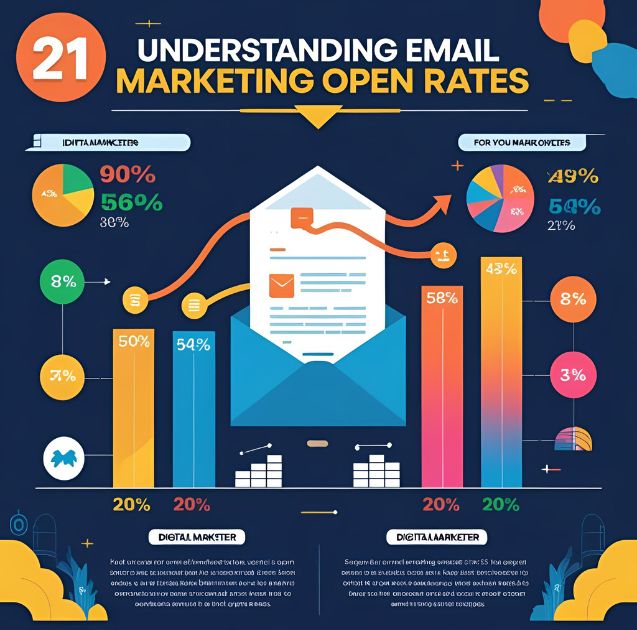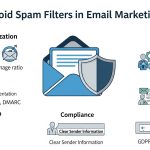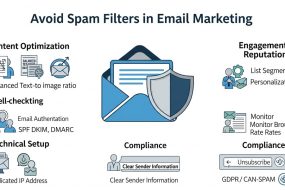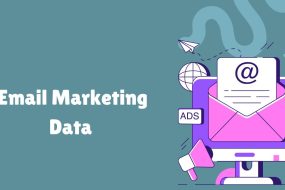
Email marketing remains one of the most effective digital marketing channels, but success hinges on one crucial metric: open rates. Understanding what constitutes a good open rate can help you benchmark your campaigns and identify areas for improvement.
Open rates indicate how many people actually opened your email out of those who received it. This metric serves as your first indicator of campaign performance and audience engagement. However, average open rates vary significantly across industries, email types, and audiences.
This guide will break down current email marketing open rate benchmarks, explore the factors that influence these rates, and provide actionable strategies to improve your own email performance.
Understanding Email Marketing Open Rates

An email open rate represents the percentage of recipients who opened your email campaign. The calculation is straightforward: divide the number of unique opens by the number of emails delivered, then multiply by 100.
For example, if you send 1,000 emails and 200 people open them, your open rate is 20%.
However, measuring open rates has become more complex due to privacy updates from major email providers. Apple’s Mail Privacy Protection and similar features now pre-load images in some emails, which can inflate open rate statistics since most email platforms track opens through tiny tracking pixels.
Despite these measurement challenges, open rates remain a valuable benchmark for email marketing performance when interpreted alongside other metrics like click-through rates and conversions.
Industry Benchmarks for Email Marketing Open Rates
Email marketing open rates vary significantly across different industries and business types. Here’s what current data reveals about average performance:
Overall Email Marketing Averages
Across all industries, the average email open rate typically falls between 18% and 25%. However, this broad range reflects the diversity of email types, audiences, and industries included in these calculations.
Most email marketing platforms report slightly different averages based on their user base, but the general consensus places healthy open rates in the 20-25% range for most businesses.
Industry-Specific Open Rates
Different industries experience varying levels of email engagement based on their audience expectations and content types:
Government and Public Sector: Often sees the highest open rates, frequently exceeding 30%, as recipients typically expect important information and updates.
Nonprofit Organizations: Generally achieve strong open rates around 25-28%, as subscribers often have high engagement with causes they support.
Education: Universities and educational institutions typically see open rates between 22-26%, particularly for student and alumni communications.
Healthcare: Medical and healthcare emails often achieve 20-24% open rates, as health-related content tends to be prioritized by recipients.
Financial Services: Banks and financial institutions usually see open rates around 18-22%, as these emails often contain important account information.
Retail and E-commerce: Fashion, beauty, and general retail typically achieve 15-20% open rates, with significant variation based on brand loyalty and email frequency.
Technology and SaaS: Software and tech companies often see open rates between 18-22%, varying significantly based on whether emails are promotional or educational.
Factors That Influence Email Marketing Open Rates
Several key factors determine whether recipients will open your emails:
Subject Line Quality
Your subject line serves as the first impression and primary factor in open rate success. Effective subject lines are typically:
- Clear and specific about the email content
- Between 30-50 characters for optimal mobile display
- Free from spam trigger words
- Personalized when appropriate
- Create curiosity without being misleading
Sender Name and Reputation
Recipients are more likely to open emails from recognizable, trusted senders. Factors include:
- Using a consistent sender name
- Maintaining a good sender reputation through proper email practices
- Avoiding spam complaints
- Building brand recognition over time
Send Time and Frequency
When and how often you send emails significantly impact open rates:
- Tuesday through Thursday typically see higher open rates
- Mid-morning (9-11 AM) and early afternoon (1-3 PM) often perform well
- Avoiding over-sending, which can lead to fatigue and unsubscribes
- Testing different send times for your specific audience
List Quality and Segmentation
The quality of your email list directly correlates with open rates:
- Lists with engaged, opted-in subscribers perform better
- Segmented lists based on demographics, behavior, or preferences see higher engagement
- Regular list cleaning removes inactive subscribers
- Permission-based lists outperform purchased lists significantly
Mobile Optimization
With over 60% of emails opened on mobile devices, mobile optimization is crucial:
- Responsive email design
- Short, mobile-friendly subject lines
- Clear, tappable calls-to-action
- Fast-loading content and images
Email Marketing Types and Their Open Rates
Different types of email campaigns typically achieve varying open rates:
Welcome Emails
Welcome emails consistently achieve the highest open rates, often exceeding 50-60%. New subscribers are most engaged immediately after signing up, making welcome emails crucial for setting expectations and building relationships.
Newsletter Emails
Regular newsletters typically see open rates between 18-25%, depending on content quality and subscriber engagement. Educational content and industry insights often perform better than purely promotional newsletters.
Promotional Emails
Sales and promotional emails usually achieve lower open rates, typically 15-20%, as recipients may experience promotional fatigue. However, well-timed promotions aligned with customer behavior can achieve higher rates.
Transactional Emails
Order confirmations, shipping notifications, and account updates typically see very high open rates (40-60%) because recipients expect and need this information.
Re-engagement Campaigns
Emails targeting inactive subscribers often see mixed results, with open rates typically ranging from 10-20%, but can be valuable for list cleaning and reactivating dormant subscribers.
Strategies to Improve Your Email Marketing Open Rates
Improving your email open rates requires a systematic approach across multiple areas:
Optimize Your Subject Lines
Test different subject line approaches:
- A/B testing different styles and lengths
- Using personalization tokens appropriately
- Creating urgency without being pushy
- Asking questions that spark curiosity
- Avoiding ALL CAPS and excessive punctuation
Improve List Building and Segmentation
Focus on quality over quantity:
- Use double opt-in to ensure subscriber intent
- Segment lists based on demographics, purchase history, or engagement levels
- Create targeted content for different audience segments
- Regularly clean your list to remove inactive subscribers
Optimize Send Times
Test and analyze your audience’s behavior:
- Experiment with different days and times
- Consider time zones for your audience
- Analyze your email platform’s analytics to identify patterns
- Test seasonal variations in optimal send times
Enhance Sender Reputation
Build trust and recognition:
- Use a consistent sender name and email address
- Maintain good sending practices to avoid spam filters
- Monitor spam complaints and unsubscribe rates
- Gradually increase the sending volume for new domains
Personalize Content
Make emails relevant to individual recipients:
- Use subscriber names in subject lines and content
- Send content based on past behavior or preferences
- Create automated email sequences based on the customer journey
- Use dynamic content that changes based on subscriber data
Tools and Analytics for Tracking Email Marketing Performance
![]()
Effective email marketing requires proper measurement and analysis:
Email Marketing Platforms
Most email marketing platforms provide detailed analytics:
- Open rates by campaign and over time
- Click-through rates and conversion tracking
- Subscriber growth and churn rates
- A/B testing capabilities for subject lines and content
Advanced Analytics
For deeper insights, consider:
- Heat mapping tools to understand how recipients interact with your emails
- Customer lifetime value tracking to measure email marketing ROI
- Attribution modeling to understand email’s role in the customer journey
- Integration with web analytics to track post-click behavior
Moving Beyond Open Rates: A Holistic Approach
While open rates remain important, successful email marketing requires attention to multiple metrics:
Click-Through Rates
Click-through rates measure how many recipients clicked links within your email. This metric often provides better insight into content effectiveness than open rates alone.
Conversion Rates
Ultimately, conversions matter most. Track how many email recipients complete desired actions like purchases, sign-ups, or downloads.
Revenue Per Email
For businesses, revenue per email sent can be more meaningful than open rates, as it directly ties email marketing to business outcomes.
List Growth Rate
Healthy email programs balance subscriber acquisition with retention, maintaining steady list growth over time.
Take Action on Your Email Marketing Strategy
Understanding average open rates provides valuable context for your email marketing performance, but remember that benchmarks are just starting points. Your industry, audience, and content strategy will all influence what constitutes success for your specific situation.
Focus on consistently improving your email marketing fundamentals: building quality lists, crafting compelling subject lines, sending relevant content, and testing different approaches. Track your performance over time rather than obsessing over individual campaign results.
Most importantly, remember that email marketing success extends far beyond open rates. While a 25% open rate might seem impressive, a 15% open rate that drives more conversions and revenue could be far more valuable for your business.
Start by auditing your current email marketing performance, identifying areas for improvement, and implementing systematic testing to optimize your campaigns. With consistent effort and attention to best practices, you can achieve open rates that not only meet industry benchmarks but also drive meaningful business results.


















No Comments